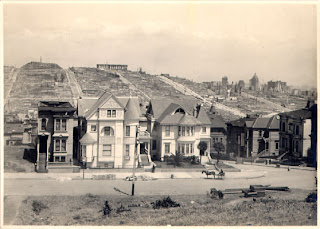[My SF Past] Lafayette Park
3 views
Skip to first unread message
Gloria Lenhart
Jul 29, 2012, 3:44:09 PM7/29/12
to san-francisco-adv...@googlegroups.com
Twin Palm Trees
Sacramento at Octavia
Two palm trees flank a walkway that once led up to the Holladay house at the top of the hill in Lafayette Park. Some say these trees were transplanted here after the Pan Pacific Exhibition, but since Samuel Holladay died several months before the Exhibition closed, that’s unlikely.
Lafayette Park – Holladay Hill
Crest on eastern side of Lafayette Park
The Van Ness Ordinance of 1855 designated this four-block hilltop as a public park, but development was slow. It was still a barren sand hill in 1869, when Samuel Holladay claimed a parcel on top of the hill in the middle of the park, with a view of downtown. He built a mansion there, on what became known as Holladay Heights
The city tried to evict Holladay from the property, but Holladay was lawyer, experienced in settling land claims. To defend his claim on the property, he began a series of lawsuits that went on for more than 40 years. The courts did ultimately award him ownership. The mansion fell into disrepair after Holladay's death in 1915. Its ruins were demolished in 1930 and the city reclaimed the land.
The city tried to evict Holladay from the property, but Holladay was lawyer, experienced in settling land claims. To defend his claim on the property, he began a series of lawsuits that went on for more than 40 years. The courts did ultimately award him ownership. The mansion fell into disrepair after Holladay's death in 1915. Its ruins were demolished in 1930 and the city reclaimed the land.
 |
| Refugee Tents in front of Holladay house Lafayette Square 1906 |
Photo Credit: University of California, Bancroft Library.
Holladay was an amateur scientist who had already built a conservatory and laboratory next to his mansion when his friend George Davidson asked if he could add an observatory, the first on the West Coast. Davidson was a surveyor and an enthusiastic astronomer who later convinced James Lick to finance construction of a larger observatory on Mt. Hamilton in Santa Clara County and also helped build the Chabot Observatory in the Oakland Hills. Mt. Davidson, the city's tallest peak, is named in his honor.
Lafayette Park Apartments
Holladay sold off two parcels of land on the Gough Street side of his property to finance his ongoing lawsuits against the city. The apartment house, now condos, was built in 1908. The building was later owned by local real estate mogul Louis Lurie, owner of the Mark Hopkins Hotel. The courts have upheld the building owners' right to the property, with one condition -- if the building loses its value, the land will revert back to the city. Until then the owners can enjoy their location in the middle of the park.
Looking east from Holladay Hill in Lafayette Park after the 1906 Earthquake. Note the remains of Fairmont Hotel at the top of Nob Hill (center left) and downtown (at right). The Queen Anne Victorians in the center of this photo still stand on Gough Street today.
Photo Credit : San Francisco Public Library AAC-3234
--
Posted By Gloria Lenhart to My SF Past at 10/01/2011 12:42:00 AM
Reply all
Reply to author
Forward
0 new messages

